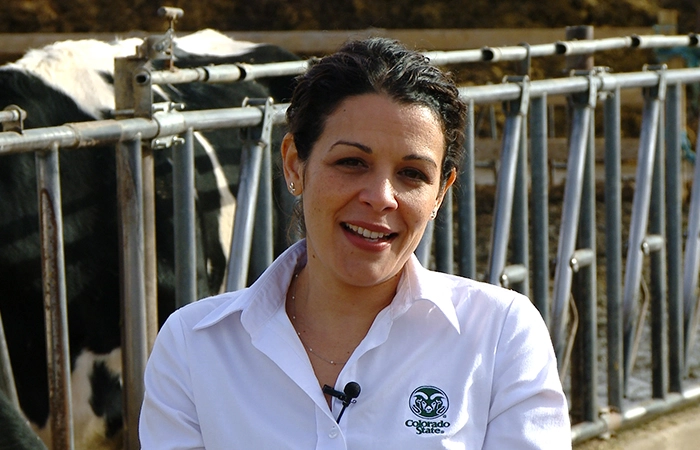This Professor Shares Her Passion for Dairy Cows
Noa Roman-Muniz loves teaching her students and the community about dairy cows.
As associate professor in the department of animal sciences and extension dairy specialist for Colorado State University, she educates people about how dairy cows and people contribute to each other’s wellbeing.
Specifically, Roman-Muniz’s research is focused on effective communication, including educational opportunities that are in agreement with the culture of the group being taught, and the relationship between human and animal health, wellbeing and performance on dairy farms.
Read on to learn about what inspires her—and what her students think are her nerdiest dairy-related conversations.
First, tell us a little bit about your job and what motivates you professionally.
I divide my time teaching, conducting research and doing outreach. I get to teach undergraduate as well as graduate students. I currently coordinate two undergraduate courses (Dairy Systems and Prevention and Control of Livestock Diseases). I also teach in a number of additional courses as a guest lecturer.
I love interacting with students and engaging them in discussions about animal welfare, dairy production, and how to build bridges between the ag community and consumers. I get to collaborate with faculty from other departments and colleges, as well as dairy producers and their employees. These diverse perspectives make research meaningful and fun.
My outreach activities involve close collaboration with dairy farmers and Dairy Max in the planning and facilitation of dairy tours for primary and middle school students, ag and science teachers, nutritionists, dairy consumers in Colorado and even international visitors.
What motivates me is being able to engage people in meaningful discussions and to share my passion for dairy. I grew up in dairy and owe much of what I am today to dairy cows. I love seeing sparks of interest and passion for dairy and agriculture in young people. It is satisfying to know that by sharing knowledge, scientific facts and common values, we can bridge gaps and improve the welfare of dairy cows and humans alike.

What is your earliest memory of dairy?
My earliest memory is visiting dairies with my dad back when he worked for the dairy industry in Puerto Rico as a milk quality inspector. That was back in 1979 or 1980 when I was 3 or 4 years old, before we had our family farm. I remember him rushing to get to the dairy before the milk truck got there as he needed a milk sample from the bulk tank. It felt like an adventure!
What gets you most excited about dairy?
Dairy cows are simply incredible animals, and the dairy industry continues to combine husbandry with science and technology to improve their wellbeing and performance.
Which living person do you most admire?
Can I choose two? My mom and my dad. Their love for science and using it for social justice has inspired me all my life. They made science sound and look cool, and they taught me responsibility. I owe who I am to them.
What’s something people don’t know about your job?
How little time I actually spend with cows. I spend most of my time teaching people how to manage and care for dairy animals. I am frequently on dairy operations to facilitate tours, laboratory sessions and while doing research, but I seldom get to handle dairy cattle or provide veterinary care myself. I instead teach others how to do it well.
What is the nerdiest dairy-related conversation you’ve had?
As a teacher, I’d guess that many of my conversations about dairy are pretty nerdy. So, I asked my students about the nerdiest dairy conversation I had with them, and their faces lit up. I never expected them to be so excited to be asked that question. They were giggling, and they wanted me to share a couple:
I am a smell-oriented person. On several occasions I have talked about dairy smells and how I appreciate the smell of silage or manure. I’ve also shared with them that I have sat next to dairy workers during meetings and by their smell I can guess that they work in the hospital area. I couldn’t tell you exactly what I am smelling, but I pay attention to those little details.
I have had lengthy conversations about the marvel that the dairy cow is. When talking about blood flow to the mammary gland and milk synthesis, I will spend quite a bit of time pointing out how incredible udders and mammary blood vessels are.
At least they find me entertaining and appreciate my passion for dairy!















